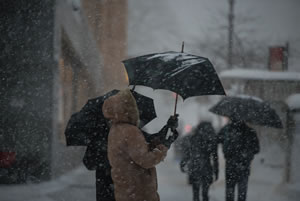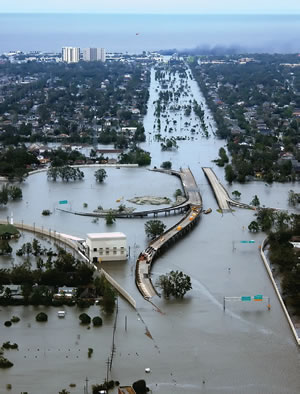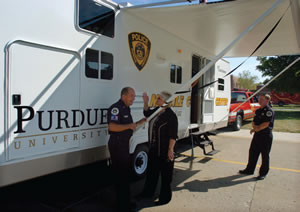It Might Happen: Tips for Preparing for Natural Disasters

PHOTO © NICK STARICHENKO / SHUTTERSTOCK, INC.
Natural disaster planning is a broad
and deep topic, with lots to do and lots to know. There’s
weather, personal preparedness, evacuation, shelter,
communication and more. Here are tips from the pros regarding
natural disaster planning that you need to know now to be
prepared should disaster strike.
Relationships
“We work closely with our student organizations,” says Ron Wright,
director of Emergency Preparedness & Planning at Purdue University
in West Lafayette, IN. “We want them to think about weather and other
things when planning their events, so we have a Special Event Emergency
Planning Checklist (http://goo.gl/4AsqAe) that we give them. If
it’s a major event, we develop an event action plan that is much more
detailed, and we will set up a mobile operations center.
“We don’t want to assume that natural disasters won’t happen,”
Wright continues, “but assume they might happen. Therefore, how
can we prepare for them to keep an event as safe as possible? Our
communication to students is, ‘Do have a fun and successful event,
as safely as possible.’”
Because of their location on the Gulf of Mexico, emergency preparedness
planners at Tulane University in New Orleans spend 30
percent of their energy and time on hurricane planning annually
(http:// goo.gl/8dAEZZ). Norris Yarbrough, CEM, LEM, assistant
vice president of Emergency Preparedness and Response, doesn’t
see that changing any time soon. And he acknowledges that the university response to hurricanes is deeply integrated with their
local and state preparedness and training partners. “For example,”
he says, “if city administrators plan to evacuate the city via contraflow,
we have to know when that’s going to occur to establish our
plans for moving students or bringing in resources.

EXPECT THE UNEXPECTED. Every college and university should have a disaster plan
in place that is tailored to its geographical location, from earthquakes to wildfires,
hurricanes, tsunamis and more. A majority of disaster potentials are, of course, weatherrelated.
Severe weather can happen anytime, in any part of the country. Severe weather
can include hazardous conditions produced by thunderstorms, including damaging winds,
tornadoes, large hail, flooding and flash flooding, and winter storms associated with
freezing rain, sleet, snow and strong winds. The Department of Homeland Security offers
guidance on their “Ready” webpage at www.ready.gov/prepare-for-emergencies for a
variety of scenarios.x
“In any type of emergency requiring an evacuation,” Yarbrough
continues, “you can’t do it in a vacuum. You have to research,
plan and work with local and state partners to be sure your plan
is integrated with theirs, otherwise you may find yourselves stuck
somewhere.” He is a member of Louisiana Emergency Preparedness
Association (LEPA), a nonprofit statewide organization of
emergency preparedness and response practitioners with the common
goal of improving public safety in emergencies. “Members
meet regularly with parish leaders to coordinate our responses so
we and the universities with which we compete are not defeating
each other when a disaster occurs,” he says. “You don’t want to be
in a competitive mindset in response to an emergency.”
“Emergency planners can receive training through the National
Weather Service (NWS) and, if you’re in Oklahoma, from Oklahoma
Mesonet,” offers Lisa Teel, OCEM, Emergency Preparedness manager,
at University of Oklahoma, Norman, which is located in the infamous
tornado alley. NWS provides weather, water and climate data, forecasts
and warnings through 122 weather forecast offices; Oklahoma Mesonet
is a network of environmental monitoring stations. “This training,”
she adds, “enables you have access to data, resources and support that
you otherwise may not have during times of severe weather. Contact
your local NWS or Oklahoma Mesonet for information.”
“We have developed an integrated emergency management
plan (http://goo.gl/LHps98),” says Purdue’s Wright. “It includes
a lot of concepts. We keep the plan current by reviewing it on an
annual basis to make sure it is as up to date as possible. It has 14
attachments, such as Emergency Procedures Guide (http://goo.gl/pbxMRX) and Purdue ALERT Emergency Warning Notification
Plan (http://goo.gl/xTPXpj). Most of the attachments are on our
emergency plan website. But sensitive ones, like the bomb threat
document, are not public for public safety.”
“Many times parents are left out of the communication loop,”
says Tulane’s Yarbrough, “and that can cause an emergency manager
some headaches when the phone starts ringing. So, on the
front end, you can do a lot to mitigate those headaches by involving
both students and parents in training. We meet with them at orientation
every year and talk about our emergency response plans
so they know what will happen if an event occurs.
“We also talk with both students and parents about our communication
plans,” Yarbrough continues. “We have a separate
communication plan that parents can opt into. The communication
is worded differently for parents; for example, acronyms that
they may not know are spelled out.”
Technology
“We have an app for students’ smart phones,” says Yarbrough,
“that allows us to establish two-way communication in an emergency.
It includes a feature where they can text messages that may be
pertinent for responding officers straight to the police dispatch unit.”
“We use Rave from Rave Mobile Safety, Framingham, Massachusetts,
for text messaging,” says Wright. “The Purdue ALERT
Emergency Warning Notification Plan provides
the structure on how we use it, who is
going to activate it and how to activate it.”
Tulane also uses Rave, and Yarbrough
notes that it is helping his team better use
social media as a major tool to communicate
with students. “We can shoot out messages
quickly,” he explains. “The Rave message on
texts and emails also goes to Twitter, and our
department’s Facebook page and website.”
Tulane administrators have partnered
with Alertus, Beltsville, MD, to provide software
that sends emergency notifications to
networked computers on which the software
is installed. Users must acknowledge notifications
before using their computers. “The
point is to have pop-up boxes on our 20,000
university desktop computers,” says Wright,
“telling people what the problem is, where it
is and what we want them to do.”
“We also have purchased 32 Alertus
beacons,” Wright says. “It’s a box on a
wall that alerts via light, LED readout and
sound. They’re placed in large areas, such
as classrooms accommodating more than
100 persons.”

PHOTO COURTESY OF PURDUE UNIVERSITY
“We’ve recently incorporated 185 digital
signs across campus,” says Wright. “Not all
the digital signs are capable of getting our
text messages. As the old signs are retired,
the number of signs capable of receiving
text messages increases.”
Physical
“The importance of fire and smoke
dampers is often overlooked,” says Sarah
Buckingham, marketing manager at Ruskin
(a brand of Johnson Controls) in Kansas
City, MO. “Fire and smoke dampers should
be used in conjunction with the campus
sprinkler system. Sprinkler systems can
fail, and having fire and smoke dampers
installed in the ductwork allows for the fire
and smoke to be contained or isolated to
minimize life and property loss.”
“Preparedness is a conversation that begins
in early facility design and planning,
whether it’s renovation or new construction,”
says Yanel de Angel, AIA, LEED-AP
BD+C, associate principal in the Boston
office of Perkins+Will. “For example, understanding
how materials might behave in
case of fire or flood informs healthy materials
specifications guidelines.”
“Often overlooked,” de Angel observes,
“is that being independent from the town
or city’s power generation allows campuses
to stand on their own during a time of
emergency in case power goes down. This
is an opportunity for campus facilities to
serve as emergency shelters for the surrounding
community.”
“Design any future buildings to serve as a
FEMA storm shelter,” says Theodore (Todd)
R. Jacobs, vice president in the St. Louis
office of KAI Design & Build. “FEMA offers
grants that can be applied to the cost of the
building shell and life safety requirements.”
In 2014, University of Oklahoma administrators
conducted an assessment of several
buildings identified as possible places to
safely shelter large numbers of individuals.
“As a result of that assessment,” says Teel,
“we have many locations across campus
identified as Best Available Refuge Areas.
These buildings are left open during times
when we expect large or violent tornadoes,
even if the rest of campus closes and individuals
go home. We staff each with severe
weather coordinators, who are trained
annually and given supplies that better help
them manage large numbers of individuals
who may not be familiar with campus.”
“Consider resistive design improvements
when designing a building,” offers
Jacobs. “Upgrades in the structure will help
in sustained wind or earthquake events —
going above the minimum code for a stiffer
structure.”
“Design building entrances and perimeters
to prevent a heavy truck from being
used as a weapon,” continues Jacobs. “This
can be done through the use of bollards
and planters.”
“Administrators, particularly in the
Midwest where tornadoes and severe
weather are common,” says Jacobs, “should
incorporate multiple storm shelters into
their master planning, as future FEMA
codes may make them a requirement.”
This article originally appeared in the issue of .